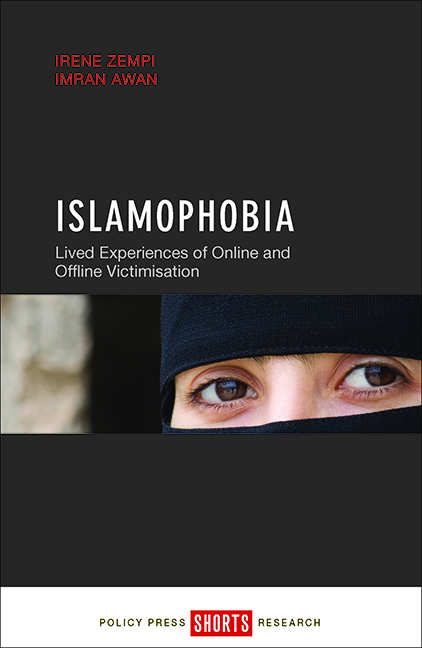Book contents
five - Impacts of online and offline Islamophobia
Published online by Cambridge University Press: 05 April 2022
Summary
This chapter discusses the impacts of online and offline Islamophobic hate crime for victims and their families. Correspondingly, participants experienced a range of psychological and emotional responses such as low confidence, depression and anxiety as well as increased feelings of vulnerability, fear and insecurity. Additionally, participants highlighted the relationship between online and offline Islamophobia, and described living in fear because of the possibility of online threats materialising in the ‘real’ world. Many participants reported taking steps to become less ‘visibly’ Muslim – for example by taking the veil off for women and shaving their beards for men, or having a western name – in order to protect themselves from future abuse.
Emotional and psychological impacts
Generally speaking, crime can incur a number of different ‘costs’ following a victimisation experience such as psychological, emotional, physical and financial implications. However, research shows that hate crime has specific psychological effects upon victims (McDevitt et al, 2001; Herek et al, 2002). In this regard, hate crime often contributes to symptoms associated with post-traumatic stress disorder (PTSD), such as anxiety, anger and despair (Otis and Skinner, 1996; Herek et al, 2002). Studies indicate that hate crime ‘hurts more’ than other forms of crime on the basis that hate crime is more damaging and traumatic for victims than other types of crime (Iganski, 2001). Specifically, hate crime studies highlight the more severe impact for victims of hate crime when compared to non-hate victims (see, for example, Smith et al, 2012; Chakraborti et al, 2014; Williams and Tregidga, 2014).
Our participants reported experiencing a range of psychological and emotional responses to online and offline Islamophobia such as guilt, anger, fear, sadness, low confidence, isolation and helplessness. Given that they were targeted because of the ‘visibility’ of their Muslim identity – which was easily identifiable because of their Muslim name and/or Muslim appearance either online or offline – participants were unable to take comfort in the belief that what happened to them was simply random and ‘could have happened to anyone’. Rather, they were forced to view this abuse as an attack on their Muslim identity.
- Type
- Chapter
- Information
- IslamophobiaLived Experiences of Online and Offline Victimisation, pp. 55 - 68Publisher: Bristol University PressPrint publication year: 2016



